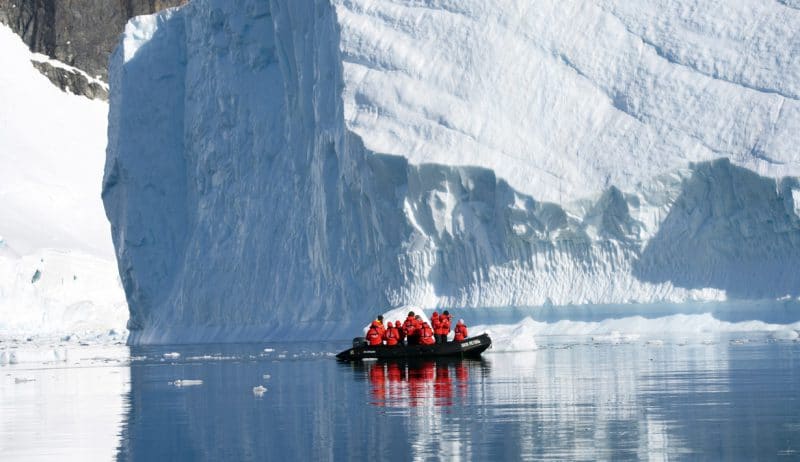
Antarctica is one of those places where you’ve probably not been but should. Not many people know a lot about it. For instance, is it a country or a continent? Who owns it? And what’s the landscape and wildlife like there? So we’ve put together a guide to Antarctica to help you learn more about it, and add it to your list of places to visit.
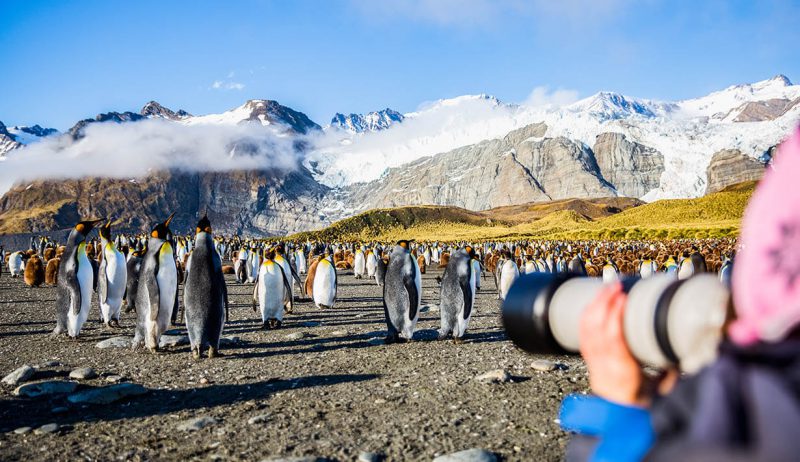
Physical Geography
Antarctica is the world’s most southern and fifth-largest continent and shouldn’t be confused with the South Pole, which is actually part of the continent. It’s around twice the size of Australia and 98% of it is totally covered in ice. Antarctica is also considered to be the coldest, driest and windiest continent on the Earth, and for these reasons there are no permanent human residents. But many – around 5,000 – live there at various times of the year, and the only creatures found there have adapted to deal with an environment where it can drop to as low as 89 degrees C.

Our Pick of Antarctica’s Natural Phenomena
Mt Erebus – This is where fire and ice collide; the world’s southernmost active volcano is an unmissable natural sight on any Antarctica cruise expedition. According to Greek myth, Erebus was the son of chaos, and as this volcano is one of few which are consistently active, the name is perfect. It was discovered in 1841 by explorer Sir James Clark Ross and has been attracting curious minds ever since. Although the surrounding landscape is so cold that you can freeze to death, the inside of Mt. Erebus is extremely hot and features a 1,700-degree Fahrenheit lava lake – one of only five that exist in the entire world.
McMurdo Dry Valleys – Probably the closest you’ll get to landing on Mars. Amidst the harsh icy world where almost nothing survives, the intriguing McMurdo Dry Valleys attract researchers and brave souls to their arid ice and snow-free landscape. The space-like terrain of these valleys is created by the 200mph winds which are sucked down into the valley, heating up as they go and sucking out any moisture with them. Meanwhile, the high mountains surrounding them prevent any ice sheets from forming, leaving just the dry rocky earth. Antarctica cruise expeditions have allowed scientists to visit this strange place and make some incredible discoveries about life in this mysterious world.
Blood Falls – One such discovery lies in the strange five-story blood-red waterfall that pours slowly out of the Taylor Glacier. Discovered in 1911, scientists first thought that the gorey colour was due to algae – the real reason was much more incredible. Beneath the glacier lies a lake that’s over 2 million years old and is home to an ancient community of microbes. With no light, oxygen and a very small amount of heat, these microbes demonstrate how life can exist in the harshest and almost unimaginable conditions on the planet. And the blood colour? That’s caused by the very high iron content. Whether you’re on an Antarctica cruise expedition for adventure or science, Blood Falls are a wonder to behold.
Lake Vostok – If you don’t know Lake Vostok, now’s the time to get familiar with it because it’s an incredible discovery. In 1996 Russian scientists were drilling ice core samples and happened to stumble upon what turned out to be the largest warm-water subglacial lake in the world – roughly the size of Lake Ontario. The freshwater lake has been trapped beneath the glacier for nearly a million years. The water is extremely pristine and it’s been confirmed that the ancient lake plays host to living organisms that are found nowhere else on earth. However, due to the untouched nature of the environment, scientists have to be careful not to contaminate the lake. It’s not open to visitors on an Antarctica cruise expedition but it’s definitely worth knowing about.
South Pole – Considered the most remote place on earth, the Southern Pole of Inaccessibility is 878km from the South Pole. Plus, with an average year-round temperature of 57.8 degrees Celsius, it’s not hard to understand why it doesn’t see that many visitors. Although you can arrange to visit the South Pole along with your Antarctica cruise expedition, the Southern Pole of Inaccessibility will be a bit more of a mission.
Although conditions on the continent are harsh, there is a surprising variety of flora and fauna to discover on an Antarctica cruise expedition. In terms of plant life, there are about 800 species, 350 of which are lichen. This hardy plant is well adapted to the barren world. There are also many mosses and plankton which call this frozen landscape home. Fauna, on the other hand, is a little more sparse and the native land animals are mostly invertebrates. This includes several parasites that live on birds and seals. Although there are around 45 species of birds living south of the Antarctic Convergence, only three species actually breed on the continent: the emperor penguin, Antarctic petrel, and South Polar skua.
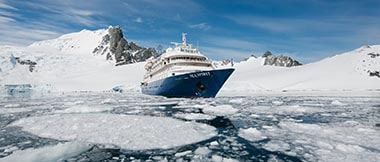
If travelling at the right time of the year, you’re likely to be treated to fantastic sightings of these beautiful creatures. The Antarctic is something of a haven thanks to the lack of mammalian predators. The waters around the continent are also extremely nutrient-rich – which means they’re attractive to seals, whales, fish and squid. This includes the famous leopard seal, which is an impressive animal to spot.
When to Visit
Throughout autumn and winter, the majority of Antarctica’s coastline becomes impassable as the ice thickens and temperatures can drop to -60 degrees Celsius. For any Antarctica cruise expedition, the best time of the year is during the summer, which falls between November and March. Due to high demand, it’s best to start planning your trip about 12 months in advance.

What You’ll Get to See
The White Continent is one of the few must-see places on the planet. It has a number of fantastic natural features not found anywhere else on Earth. The Amery Ice Shelf, for example, is a huge expanse of floating ice that is as spectacular as it sounds. Deception Island is also worth a visit. It’s an active volcano – don’t worry, the last eruption was in 1970 – where you can see steaming beaches and glaciers layered with ash and has a natural harbour sheltered from the harshest of the elements so ships can sail right through it. There aren’t many other places around where you can get so close to a volcano on a boat!

You should check out the spectacular Transantarctic mountains too. They form the natural barrier between the East and West Antarctic and span the entire length of the continent. At 3,500 km, spanning from Victoria Land to the coastline of the Weddell Sea, they are one of the largest mountain ranges anywhere in the world. They’re also impressively high, rising to 14,856 feet at Mount Kirkpatrick in the Queen Maud Mountains. Early explorers Ernest Shackleton and Roald Amundsen were the first people to cross them.
The landscape is covered mostly by ice and many large glaciers and the range is made up of several major subdivisions including Shackleton, Queen Alexandra and Prince Albert mountains. It might look like a stark landscape, but it’s the site of the world’s largest coal deposits and fossils of freshwater amphibians and reptiles. There is still much to learn from these mountains and several research stations have been set up along the range, attracting Antarctica cruise expeditions for scientific purposes.
Profile of Ernest Shackleton
Ernest Henry Shackleton was born on 15th February 1874 in County Kildare, Ireland. He grew up in London, where he was educated but, rejecting his father’s wishes for him to become a doctor, Shackleton joined the merchant navy at age 16 and became a master mariner. It was during this time that his curiosity to explore the poles began. In 1901, Shackleton was selected to join the Antarctic expedition led by Robert Falcon Scott on the ship ‘Discovery’. It was on this trip that they reached closer to the South Pole than anyone before. But due to illness, Shackleton had to return home. In 1914 that Shackleton made his famous third – and final – expedition with the ship ‘Endurance’. However, the ship was trapped and eventually sank. Shackleton and his team had to abandon the ship and make their way back to the land of the living on floating ice. After the ordeal of reaching Elephant Island and finding help, Shackleton’s ‘Endurance’ expedition came to an end and was immortalised in his account ‘South’.
Profile of Roald Amundsen
Renowned for beating Scott to the South Pole and for being the first person to take a transarctic flight across the North Pole, Roald Amundsen is one of history’s most famous explorers. Born in Borge, Norway in 1872, Amundsen was fascinated with polar exploration from a young age. He eventually quit university to work with Arctic whaling skippers to gain experience. However, it was his planning skills that made him a fantastic explorer. He learned how to use furs, drive dogs and build igloos from native communities, skills which were essential to him when travelling to the South Pole. Although he was an excellent explorer himself, Amundsen credited his success at the South Pole to his whole team and they celebrated with a bottle of champagne. After the First World War, he went on to become the second person to complete the North-East Passage around Siberia. But that was not enough for the intrepid explorer. In 1925, he flew an airship to Alaska via the North Pole, completing the first transarctic flight across the pole.
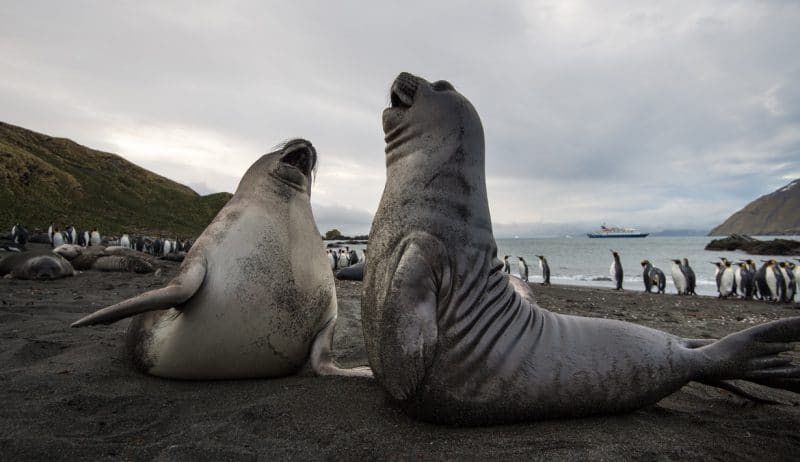
Wildlife Bonanza
A number of animals are native to the region, including seals and penguins, and you can expect excellent wildlife on your Antarctica cruise expedition. Seals include Antarctic fur seals, Crabeater seals, Leopard seals, Weddel seals and Southern elephant seals. All have massive populations and mainly eat the fish and krill which swim in the seas around the continent. Leopard seals are the most fearsome as they will make a meal of other seals and penguins given the chance but mainly eat krill and shrimps.
A Glossary of Seals
Fur seals – These furry seals breed in South Georgia but the young males travel to the South Shetland Islands and the Antarctic Peninsula from January to March, so you should be able to spot them on your Antarctica cruise expedition. They’re quite confident on land and so watch out for sharp teeth!
Leopard seals – Speaking of sharp teeth, these animals are renowned for their razor-like teeth and dangerous jaws. They like to hunt penguins and other seals – especially pups. You’ll find them throughout the peninsula.
Weddell seals – This seal lives further south than any other mammal (excluding humans). Their population is doing well so you’re likely to see one of these – they can even be found at McMurdo Sound.
Southern elephant seals – Named for their trunk-like snout, these are the largest seals in the world with males weighing up to 3.5 tonnes. They’re mostly found in the Southern Islands and throughout the Antarctica Peninsula. Livingstone Island is the best place to find them, especially during the winter. In the summer – a bit like us – they’ll be hitting the beaches.
Crabeater seals – These guys are harder to find as they prefer to live on pack ice rather than the open sea. Mating occurs between September and November on the pack ice in the Antarctic Peninsula.
Penguins
There are a number of penguins living in Antarctica too – namely the Adelie penguin, Chinstrap penguin, Emperor, King penguin, Macaroni and Gentoo penguin. They all thrive in the icy landscape as they have thick feathers and layers of fat to keep them warm and have plenty of fish and sea creatures to feast on. But that’s not to say that they’re all the same. Each penguin has their own way of surviving in the harsh landscape and they each have its unique features.
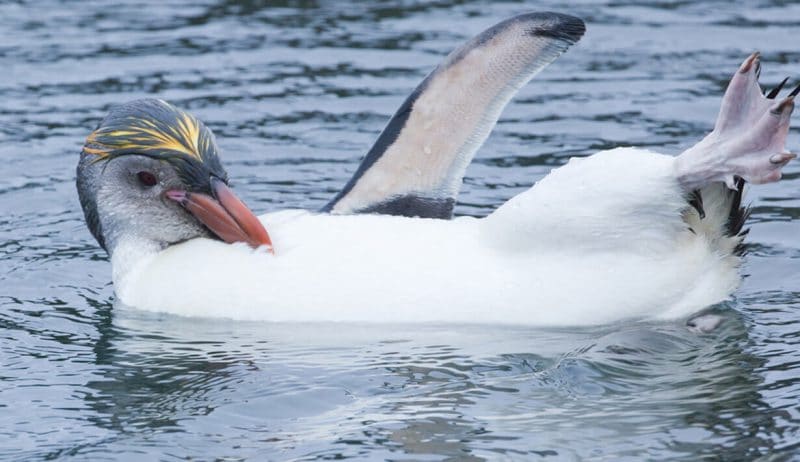
- The Adelies – spend winter in the seas around the peninsula so they’re much easier to spot from spring to autumn. They’re also amazing divers and have been recorded at diving as deep as 575 feet for food.
- The Chinstraps – have an interesting mating ritual whereby the males have to race to find the best nests.
- Emperors – the largest of the penguins; their colonies are found in the south of the continent.
- King – similar to the Emperor but with more grey colour on their backs. You’ll find these guys further north than emperors and they only spend part of the year in the region.
- Macaroni – the most abundant penguin species and definitely the most eccentric-looking.
- Gentoos – the speedy penguins. They may be a little clumsy on land, but in the water that can reach speeds up to 22 mph.
Other animals found there are Antarctic Minke whales and Killer Whales – the continent’s most feared predator.
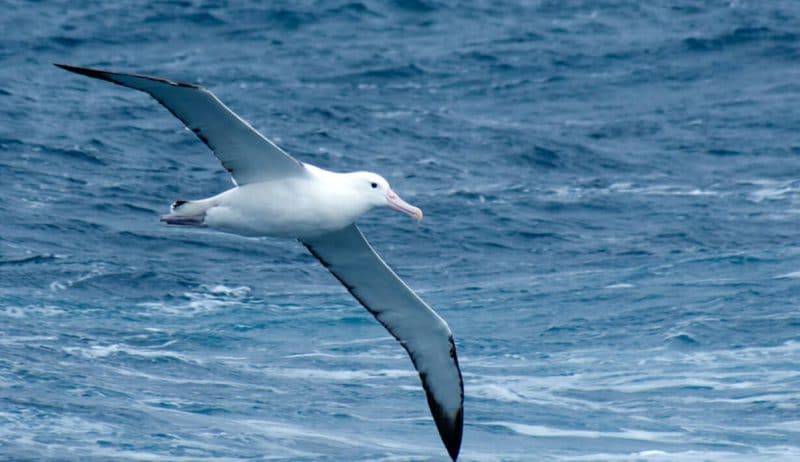
Antarctica is also home to numerous bird species including albatrosses, skuas and petrels. In fact, if you’re into bird watching, there’s no better place in the world. There are in fact 46 species living in and around this cold habitat, so there are plenty of opportunities to spot something fantastic. Many Antarctica cruise expeditions have their own ornithologists on board as well, which means you’ll get to learn about the beautiful birds as you spot them along your journey.
A Checklist for Birdwatchers on our Antarctic Cruise Expeditions
- Wandering Albatross – typically found on the Crozet Islands, South Georgia Island and Prince Edward Islands. They’re the most common birds in Antarctica.
- Snow Petrel – spend most of the winter on the cold Antarctic seas. They nest in the Scott Islands, the Balleny Islands, South Orkney, South Georgia, and the South Sandwich Islands.
- South Polar skua – as pelagic birds, they spend all their lives at sea. But you may spot them in the parts of the Southern Hemisphere as well.
- Great Shearwater – one of the few southern hemisphere birds that migrate to the northern hemisphere. They breed throughout the Antarctica region.
- Brown skua – also known as Antarctic skuas as they breed in the Antarctic regions.
- Kelp gull – mostly found in South America, Southern Africa and Australia.
- Southern fulmar
- Falkland Steamer Duck – they spend the whole year on the shores of the Falklands, but you may see them in other regions as well.
- Yellow-billed pintail – a species of duck that is found in high elevation marshes, lakes, coasts, and rivers in South Georgia, Falklands and South America.
- Striated caracara – dark feathered raptors found in the Falkland Islands. They tend to be restricted to the southernmost parts of the Southwest Atlantic.
Antarctica’s unique because no one can lay claim to fully owning it. Great swathes are owned by Australia, with Norway also owning a significant share. Chile, New Zealand, France, the United Kingdom and Argentina also all have territory there, with several disputes for land still in place.
Whale Watching on an Antarctica Expedition Cruise
No Antarctica cruise expedition is complete without whale watching. But there are a few things to consider before heading out.
When to go
February and March are the best months to spot whales in this part of the world. During this time, the numbers are at their peak and the whales are their most playful, which makes for some great photo opportunities. After fasting through the winter months, they will gorge themselves on food so by February they’re full of energy and ready to put on a bit of a show.
Whale behaviour
- Diving – this is the chance to see that big, beautiful tail go high into the air as they prepare to deep dive.
- Lobtailing – thought to be a kind of communication, this is when they slap their flukes on the water.
- Breaching – they will shoot themselves out of the water and may twist their body before smashing back down. The theory is that this is just for fun or even to give themselves a good scratch.
- Spyhopping – lifting their heads out of the water to get a better look at you and the surrounding area. If you’re close to them, this is definitely an unforgettable moment.
There are many ways you can whale watch on your Antarctica cruise expedition, but one of the best ways to get up close to these incredible creatures is in a zodiac boat or a kayak.
Frequently Asked Questions
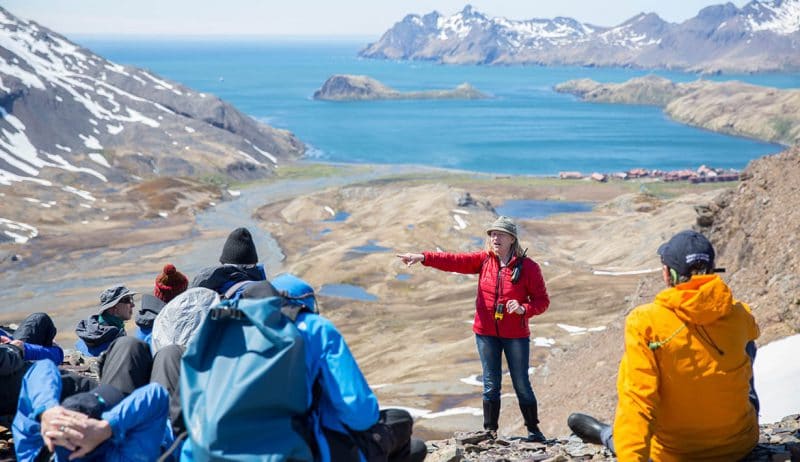
Now you know all the wonderful reasons why an Antarctica cruise expedition is an unforgettable trip, you’ll probably have a few questions. We’ve answered some of the most common queries below so that you know everything you need to before planning your icy adventure!
Is it possible to take a cruise around Antarctica?
Yes! We offer a variety of itineraries of Antarctica cruise expeditions depending on what you’d like to do and see whilst exploring this part of the world. It might be the most remote continent on the earth but there are a number of vessels that can take you around the wild world of snow and ice.
What is an expedition cruise?
Expedition cruises are very similar to traditional cruising. The main difference is that there is more emphasis on the experiences onshore and the activity side of the trip. As you can imagine, adventure is at the core of visiting the world’s last great wilderness. So think, a little less sunbathing and a little more exploring!
How long is an expedition to Antarctica?
The length of your trip will depend on the itinerary. Shorter expeditions can be about 8 days whilst longer ones that include a few stops along the way can be around 20 days. It will just depend on where you want to go.
Where do Antarctic cruises leave from?
Again, this will depend on your itinerary. If the Falklands are on your trip, then you may depart from Stanley. Ushuaia, the southernmost city in the world, is also a common starting point.
How safe are Antarctic cruises?
Generally, an Antarctic cruise expedition is just as safe as a Mediterranean cruise – it’s just a little colder! The vessels have been rigorously tested before sailing and are designed for polar travel so all you need to worry about is packing enough layers.
Some of Our Favourite Antarctica Expedition Cruises
As you can probably tell from this guide, an Antarctica cruise expedition has so much to offer. From incredible wildlife sightings to explorations of some of the most fascinating sites of scientific interest in the world. You’ll be able to get close and personal with it all. However, that’s not to say that every trip is the same. Here are a few of our favourite routes that will be able to cater to your specific needs and make your adventure unforgettable.
South Georgia & The Falklands Special

This 15-day sail takes you through a region that is full of wildlife, history and stunning scenery. Your trip begins at Stanley, the capital of Falklands, from there you’ll explore the beautiful archipelago and continue onto South Georgia where glaciers and penguins wait to be discovered.
Cape Horn & The Falkland Islands

Aboard a modern vessel, you’ll begin your expedition from Ushuaia, the southernmost city in the world. Here you’ll visit the famous Cape Horn before sailing onwards to the Falklands. Once you’ve arrived, you’ll explore all that the islands have to offer by way of wildlife, landscape and historical sites.
Luxury Falklands, South Georgia & Antarctica

This trip showcases the best of what the Antarctica cruise expeditionhas to offer. You’ll visit the three most famous areas, including the Falkland Islands, the wildlife haven of South Georgia and the South Shetland Islands. You can expect sensational scenery and fantastic wildlife sightings.
Argentina + Classic Antarctic Peninsula
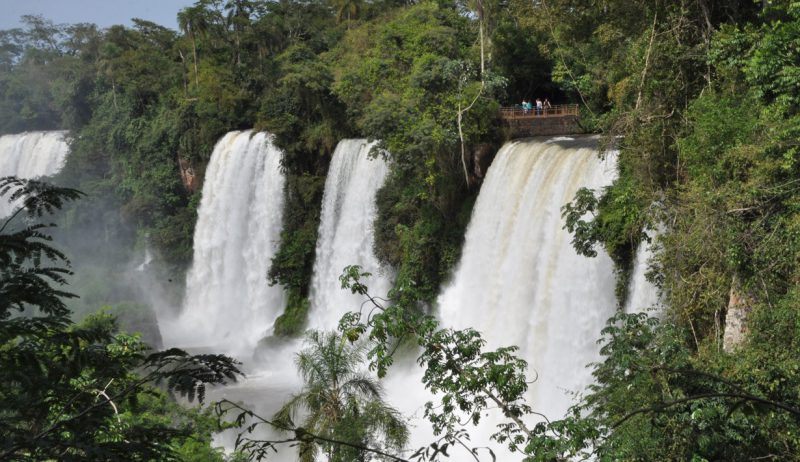
This itinerary offers the best of everything. It includes an unforgettable Argentinian tour, including visits to Buenos Aires, Iguazu Falls and of course, the Valdes Peninsula and Ushuaia. Followed by a classic Antarctic Peninsula expedition with highlights of zodiac excursions and whale watching.
